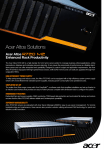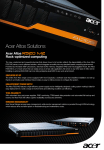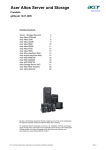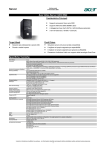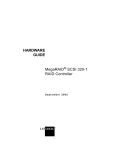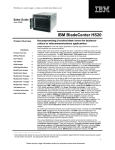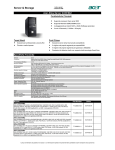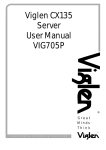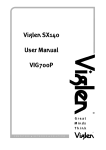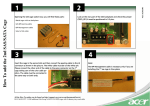Download Acer G5350 User's Manual
Transcript
Acer Altos G5350 Series
User’s Guide
Copyright © 2005 Acer Incorporated
All Rights Reserved.
Acer Altos G5350 Series
User’s Guide
Changes may be made periodically to the information in this publication without obligation
to notify any person of such revision or changes. Such changes will be incorporated in new
editions of this manual or supplementary documents and publications. This company makes
no representations or warranties, either expressed or implied, with respect to the contents
hereof and specifically disclaims the implied warranties of merchantability or fitness for a
particular purpose.
Record the model number, serial number, purchase date, and place of purchase information in
the space provided below. The serial number and model number are recorded on the label
affixed to your computer. All correspondence concerning your unit should include the serial
number, model number, and purchase information.
No part of this publication may be reproduced, stored in a retrieval system, or transmitted, in
any form or by any means, electronic, mechanical, photocopy, recording, or otherwise,
without the prior written permission of Acer Incorporated.
Acer Altos G5350 Series
Model Name : G535
Part Number: MU.R160E.001
Purchase Date:
Place of Purchase:
Acer and the Acer logo are registered trademarks of Acer Inc. Other company’s product
names or trademarks are used herein for identification purposes only and belong to their
respective companies.
iii
Notices
FCC notice
Class A devices do not have an FCC logo or FCC IDE on the label. Class B devices
have an FCC logo or FCC IDE on the label. Once the class of the device is
determined, refer to the following corresponding statement.
Class A equipment
This device has been tested and found to comply with the limits for a Class A
digital device pursuant to Part 15 of the FCC Rules. These limits are designed to
provide reasonable protection against harmful interference when the
equipment is operated in a commercial environment. This equipment
generates, uses, and can radiate radio frequency energy, and if not installed
and used in accordance with the instructions, may cause harmful interference to
radio communications. Operation of this equipment in a residential area is
likely to cause harmful interference, in which case the user will be required to
correct the interference at personal expense.
Class B equipment
This device has been tested and found to comply with the limits for a Class B
digital device pursuant to Part 15 of the FCC Rules. These limits are designed to
provide reasonable protection against harmful interference in a residential
installation. This device generates, uses, and can radiate radio frequency
energy, and if not installed and used in accordance with the instructions, may
cause harmful interference to radio communications.
However, there is no guarantee that interference will not occur in a particular
installation. If this device does cause harmful interference to radio or television
reception, which can be determined by turning the device off and on, the user
is encouraged to try to correct the interference by one or more of the following
measures:
•
Reorient or relocate the receiving antenna
•
Increase the separation between the device and receiver
•
Connect the device into an outlet on a circuit different from that to which
the receiver is connected
•
Consult the dealer or an experienced radio/television technician for help
iv
Notice: Shielded cables
All connections to other computing devices must be made using shielded cables
to maintain compliance with FCC regulations.
Notice: Peripheral devices
Only peripherals (input/output devices, terminals, printers, etc.) certified to
comply with the Class A or Class B limits may be attached to this equipment.
Operation with noncertified peripherals is likely to result in interference to
radio and TV reception.
Caution! Changes or modifications not expressly approved by
the manufacturer could void the user’s authority, which is granted
by the Federal Communications Commission, to operate this
server.
Use conditions
This part complies with Part 15 of the FCC Rules. Operation is subject to the
following two conditions: (1) this device may not cause harmful interference,
and (2) this device must accept any interference received, including interference
that may cause undesired operation.
Notice: Canadian users
This Class A/Class B digital apparatus meets all requirements of the Canadian
Interference-Causing Equipment Regulations.
Laser compliance statement
The CD-ROM drive in this server is a laser product. The CD-ROM drive’s
classification label (shown below) is located on the drive.
CLASS 1 LASER PRODUCT
CAUTION: INVISIBLE LASER RADIATION WHEN OPEN. AVOID EXPOSURE TO
BEAM.
v
Important safety instructions
Read these instructions carefully. Save these instructions for future reference.
1
Follow all warnings and instructions marked on the product.
2
Unplug this product from the wall outlet before cleaning. Do not use
liquid cleaners or aerosol cleaners. Use a damp cloth for cleaning.
3
Do not use this product near water.
4
Do not place this product on an unstable cart, stand, or table. The product
may fall, causing serious damage to the product.
5
Slots and openings on the back or bottom side of the chassis are provided
for ventilation; to ensure reliable operation of the product and to protect
it from overheating, these openings must not be blocked or covered. The
openings should never be blocked by placing the product on a bed, sofa,
rug, or other similar surface. This product should never be placed near or
over a radiator or heat register, or in a built-in installation unless proper
ventilation is provided.
6
This product should be operated from the type of power indicated on the
marking label. If you are not sure of the type of power available, consult
your dealer or local power company.
7
Do not allow anything to rest on the power cord. Do not locate this
product where persons will walk on the cord.
8
If an extension cord is used with this product, make sure that the total
ampere rating of the equipment plugged into the extension cord does not
exceed the extension cord ampere rating. Also, make sure that the total
rating of all products plugged into the wall outlet does not exceed the fuse
rating.
9
Never push objects of any kind into this product through chassis slots as
they may touch dangerous voltage points or short out parts that could
result in a fire or electric shock. Never spill liquid of any kind on the
product.
10
Do not attempt to service this product yourself, as opening or removing
covers may expose you to dangerous voltage points or other risks. Refer all
servicing to qualified service personnel.
11
Unplug this product from the wall outlet and refer servicing to qualified
service personnel under the following conditions:
a
When the power cord or plug is damaged or frayed
b
If liquid has been spilled on the product
c
If the product has been exposed to rain or water
vi
d
If the product does not operate normally when the operating
instructions are followed. Adjust only those controls that are covered
by the operating instructions since improper adjustment of other
controls may result in damage and will often require extensive work
by a qualified technician to restore the product to normal condition.
e
If the product has been dropped or the cabinet has been damaged
f
If the product exhibits a distinct change in performance, indicating a
need for service.
12
Replace the battery with the same type as the product's battery we
recommend. Use of another battery may present a risk of fire or explosion.
Refer battery replacement to a qualified service technician.
13
Warning! Batteries may explode if not handled properly. Do not
disassemble or dispose of them in fire. Keep them away from children and
dispose of used batteries promptly.
14
Use only the proper type of power supply cord set (provided in your
accessories box) for this unit. It should be a detachable type: UL listed/CSA
certified, type SPT-2, rated 7A 125V minimum, VDE approved or its
equivalent. Maximum length is 15 feet (4.6 meters).
iii
iii
iv
v
1 System tour
1
Features summary
External and internal structure
Front bezel
Front panel
Rear panel
Internal components
System boards
Mainboard layout
Backplane board layout
2 System setup
Setting up the system
Pre-installation requirements
Connecting peripherals
Turning on the system
Power-on problems
Configuring the system OS
Server setup
Turning off the system
3 System upgrade
Installation precautions
ESD precautions
Pre-installation instructions
Post-installation instructions
Opening the server
Removing the left-side panel
Opening the bezel door
Removing the front bezel
Removing the HDD cage bay cover
Configuring the four-bay hot-plug HDD cage
Installing the four-bay hot-plug HDD cage
Removing the four-bay hot-plug HDD cage
Installing an additional hard disk into the
hot-plug HDD cage carrier
3
6
6
7
11
13
14
14
17
21
23
23
24
25
27
28
29
30
31
33
33
33
34
35
35
36
36
37
38
38
50
51
Contents
Notices
FCC notice
Laser compliance statement
Important safety instructions
viii
Replacing the CD-ROM drive
Installing 5.25-inch drives
Upgrading the processor
To install the CPU
To install the HSF assembly
To remove the HSF assembly
To remove the CPU
Upgrading the system memory
DIMM population guidelines
To remove a DIMM
To install a DIMM
Installing an expansion card
Installing a SCSI module
Installing a power supply module
53
55
57
57
58
60
61
62
63
66
67
69
71
73
4 BIOS setup
77
BIOS setup
Entering BIOS setup
Main
Advanced
CPU Configuration
Memory Configuration
IDE Configuration
Floppy Configuration
Chipset Configuration
I/O Device Configuration
PCI Configuration
USB Configuration
Server Management Configuration
Power
Boot
Boot Settings Configuration
Boot Device Priority
Security
To set a Supervisor/User password
To change the Supervisor/User password
To remove the User password
Exit
79
80
82
84
85
87
88
92
93
94
96
97
98
100
102
103
104
106
107
107
107
109
5 Troubleshooting
Resetting the system
Problems following initial system installation
First steps checklist
111
113
114
115
ix
Hardware diagnostic testing
Verifying proper operation of key system lights
Confirming loading of the OS
Specific problems and corrective actions
Appendix A: System management utility
ASM
System requirements
System setup
RAID configuration
116
116
117
117
123
126
126
127
129
Appendix B: Acer Altos G5350
rack installation guide
131
Setting up the system rack
System rack installation
Vertical mounting hole pattern
Installing the system into the rack
133
135
136
138
Appendix C: SCSI RAID configuration
Configuring the SCSI/SCSI RAID HBA
Using the SCSI HBA setup utility
Using the SCSI RAID HBA setup utility
Using the MegaRAID configuration utility
147
149
149
149
150
x
1 System tour
The Acer Altos G5350 server is a powerful dualprocessor system loaded with a host of new
and innovative features. The system offers a
new standard for flexible productivity ideal for
multimedia processing, intensive graphics
applications, general business applications,
email, web service, file clustering and print
services.
3
Features summary
Listed below are the system’s key features:
Processor
•
Dual AMD Opteron™ single or dual core processors
•
Supports AMD 64-Bit technology
Chipset
•
AMD 8131™ (I/O bridge)
•
AMD 8111™ (South bridge)
Memory
•
Supports DDR-333(PC2700) or DDR-400(PC3200) registered ECC
memory modules
•
Four DIMM slots per processor
•
•
Single-processor supports memory capacity of 8 GB
•
Dual-processor supports memory capacity of 16 GB
Supports dual-channel DDR memory per processor
Media storage
•
3.5-inch, 1.44 MB floppy drive
•
Three 5.25-inch device bays supports:
•
DVD-ROM, DVD-RW, DVD combo drive
•
5.25-inch IDE CD-ROM drive
•
DAT72 tape drive
•
AIT1 tape drive
•
LTO-2 half-height tape drive
Additional media storage
•
•
SCSI HDD cage
•
Easy-swap
•
Hot-plug
•
Supports up to four Ultra320 SCSI hard disk drives
SATA HDD cage
4
1 System tour
•
Easy-swap
•
Hot-plug
•
Supports up to four SATA hard disk drives
SCSI controller (optional)
•
Adaptec AIC-7902, two channel Ultra320 SCSI controller
•
Supports two SCSI 68-pin connector
•
Supports disk mirroring
Networking
•
Intel 82541Gl chipset
Baseboard Management Controller (optional)
•
Onboard National Semiconductor PC87435 management
controller
•
IPMI (Intelligent Platform Management Interface) 1.5 compliant
PCI I/O
•
Six PCI bus slots with three separate bus segments:
•
Two 64-bit/100 MHz PCI-X bus slots
•
Two 64-bit/66 MHz PCI-X bus slots
•
Two 32-bit/33 MHz PCI bus slots
Graphic interface
•
ATI Rage® XL chipset with 8MB SDRAM
I/O ports
•
Front
•
•
Two USB 1.1 ports
Rear
•
PS/2 keyboard and mouse port
•
Two USB 1.1 ports
•
VGA/monitor port
•
Two serial ports
•
Parallel/printer port
5
•
Gigabit LAN port (RJ-45)
Operating system and software
•
Microsoft® Windows® Server 2003, X64 edition
•
Microsoft® Windows® Server 2003
•
Microsoft® Windows® 2000 Server (SP4)
•
Red Hat Enterprise Linux 4.0
•
Red Hat Enterprise Linux 4.0 X64
•
Novell® NetWare® 6.5
•
SUSE® Linux Enterprise Server 9.0
•
SUSE® Linux Enterprise Server 9.0 X86_64
Power supply
•
610-watts (1+1) redundant power supply (optional)
6
1 System tour
External and internal structure
Front bezel
No.
Component
1
Side panel release button
2
Security keylock
3
Front panel LED indicator
4
Bezel door
7
Front panel
No.
Icon
Component
Description
1
CD-ROM drive Stop/
Eject button
Press this button to open the CD
drive tray.
2
CD-ROM drive
activity indicator
When the LED indicator is lit, there
is activity in the CD drive.
3
CD-ROM drive
Disk drive for reading CD-ROMs.
4
Volume control
Adjusts the volume of the CD drive.
5
CD-ROM drive
Headphone/
Earphone port
Connects to microphones or
earphones.
6
5.25-inch drive bays
Two empty 5.25-inch drive bays
allow installation of additional
devices.
7
Power indicator 1
Indicates AC power is present or
system is turned on or off (green).
8
1 System tour
No.
8
Icon
Component
Description
Hard disk activity
Indicates the status of the system
hard drive.
indicator 2
9
System status
indicator 3
10
11
The indicator lights up green when
the system is operating normally.
When the a system fault is present,
the indicator blinks or lights up
amber.
indicator 4
Indicates an active link on the LAN
port (green).
Hot-plug HDD power
Indicates drive activity (green).
LAN activity
indicator 5
12
Four-bay hot-plug
HDD cage
Houses four hot-swap SCSI drives.
13
HDD cage bay
For additional storage options.
Supports a four-bay hot-plug HDD
cage.
14
USB ports
Connects to USB devices.
15
Power button
Press to turn on the system.
1, 2, 3, 4, 5 For more information about the status of the LED indicators, see
Front panel LED indicators table on page 9.
9
Front panel LED indicators
Below table lists the LED states on the front panel.
LED
Color
Status
Description
Power
Green
On
Power on
Blinking
System in ACPI sleep mode.
Green
On
System in normal mode.
Green
Blinking
• Defective CPU
• Defective DIMM
Amber
Blinking
• Redundant fan failure
• Redundant power supply
failure
Status
1
• Non-critical temperature and
voltage failure
Amber
On
• Critical power supply failure
• Voltage power supply failure
• Critical temperature and
voltage failure
Off
• POST error
• NMI event
• Missing CPU or terminator
HDD
Green
Amber
Blinking
HDD activity
Off
No HDD activity
On
HDD failure
The HDD LED will light green
when the four-bay hot-plug
cage is installed in the chassis.
10
1 System tour
LED
Color
Status
Description
LAN
Green
On
Network is established.
Blinking
• Network activity.
• Network is established and
running at its supported
speed.
Off
Network link is not established.
1 The Status LED is activated when the BMC controller is installed on the mainboard. To
purchase a BMC controller, contact your local Acer representative or order directly from
http://www.acer.com/.
Hot-plug HDD LED indicators
Below table lists the possible disk drive states.
HDD Status
Green
Amber
Description
HDD access
Blinking
—
HDD activity
HDD failure
—
On
Internal HDD failure, replace
HDD
HDD rebuild
Blinking
Blinking
HDD rebuilding data
11
Rear panel
No.
Icon
Component
Description
1
Power supply
module bay
Allows installation of a hot-swap
redundant power supply module.
The hot-swap redundant power
supply module may include three
LEDs that will indicate its operating
status.
Note: Though the system supports
two hot-swap power supply module
bays, the system comes bundled with
only a single power supply module.
You have the option to separately
purchase an extra power supply
module to provide the system with
redundant power source.
2
PS/2 mouse port
Connects to a PS/2 mouse.
3
PS/2 keyboard
port
Connects to a PS/2 keyboard.
12
No.
1 System tour
Icon
Component
Description
4
USB ports
Connects to USB devices.
5
Serial port
Connects to serial devices.
6
Parallel/printer
port
Connects to parallel devices.
7
VGA/monitor
port
Connects to monitors.
8
Gigabit LAN
ports (10/100/
1000 Mbps)
Connects to network cables.
9
Expansion slots
For installing expansion cards.
10
PCI slot lock
lever
Secures the PCI card to the system.
11
Rear system fan
Optimizes system airflow.
13
Internal components
No.
Component
1
Power supply module (610-watts) 1
2
Rear system fan
3
Mainboard, CPU and heat sink fan assembly
4
PCI bus slot
5
Four-bay hot-plug HDD cage
1 Though the system supports two hot-swap power supply modules, the system comes
bundled with a single 610-watt power supply module only. You have the option to
purchase an extra power supply module to provide the system with a redundant power source.
14
1 System tour
System boards
Mainboard layout
The mainboard becomes accessible once you open the system. It
should look like the figure shown below.
15
No.
Code
Description
1
CN4
Top: PS/2 mouse port
Bottom: PS/2 keyboard port
2
USB3
USB ports
3
COMA1
Serial A port
4
LPT1
Parallel/printer port
5
VGA1
VGA/monitor port
6
LAN
Gigabit LAN ports (RJ-45)
7
ATX2
Power supply connector
8
CPU2
CPU 2 socket
9
CPU FAN2
CPU fan 2 connector
10
ATX1
Power supply connector
11
PWR FAN1
Power fan 1 connector
12
DIMM 1-4
DIMM slots for CPU 1
13
DIMM 5-8
DIMM slots for CPU 2
14
CPU1
CPU 1 socket
15
CPU FAN1
CPU fan 1 connector
16
AMD 8131 chipset
17
AMD 8111 chipset
18
SCSI_CON1
SCSI module connector
19
CLR_CMOS1
Clear CMOS jumper
20
F_PANEL1
Front panel LED connectors
21
USB1
Front USB connectors
16
1 System tour
No.
Code
Description
22
IDE2
Secondary IDE connector
23
IDE1
Primary IDE connector
24
BAT1
CMOS battery
25
U109
SIO (System IO) chipset
26
GSMI1
BMC (Baseboard Management Controller)
connector
27
FDD1
FDD connector
28
COMB
Serial B port
29
PCI_6
PCI slot 5, 6 (PCI 32-bit/33 MHz)
30
JP3
VGA jumper (enabled/disabled)
31
ATI Rage XL VGA chipset
32
WOL1
WOL (Wake On LAN) connector
33
PWR_FAN2
Power fan 2 connector
34
PCI-X_1 PCI-X_4
PCI-X slots 1 and 2 ( 64-bit/100 MHz)
PCI-X slots 3 and 4 (64-bit/66 MHz)
35
BIOS Flash ROM
36
Intel 82541Gl Gigabit chipset
37
IPMB2
IPMB 2 connector
38
IPMB1
IPMB 1 connector
39
SYS_FAN1
System fan 1 connector
40
SMBUS1
System Management Bus connector
41
WOM1
WOM (Wake On Modem) connector
17
Backplane board layout
The backplane board attached to the four-bay hot-plug HDD cage
provides a convenient interface between the SCSI or SATA drives and
the mainboard.
SCSI backplane board layout
Rear
Front
No.
Code
Description
1
SCSI HDD connectors
2
I2C bus interface connector
3
4-pin power cable connector
4
SAF-TE ID
SAF-TE ID jumper
Jumper setting:
1-2 Close — ID8 (default)
2-3 Open — ID6
18
No.
1 System tour
Code
Description
J3
LED indicator jumper
Jumper setting:
SHORT 1-2 — Link LED on
SHORT 2-3 — Link LED dark
792D_ID1
792D_ID1 ADDR select jumper
Close 1-2 — 5EH (default)
Close 2-3 — 5AH
5
68-pin SCSI data cable connector
19
SATA backplane board layout
Rear
Front
No.
Code
Description
1
SATA HDD connectors
2
SAF-TE heartbeat LED and
Manufacturing function jumper
3
J1
BPB No. jumper
Jumper setting:
SHORT 1-2 — 1st BPB
SHORT 2-3 — 2nd BPB
J2
LED indicator
Jumper setting:
SHORT 1-2 — Link LED on
SHORT 2-3 — Link LED dark
792D_ID1
792D_ID1 ADDR select jumper
Close 1-2 — 5EH (default)
Close 2-3 — 5AH
4
SATA data cable connectors
20
No.
1 System tour
Code
Description
5
4-pin power cable connector
6
I2C bus interface connector
2 System setup
This chapter gives you instructions on how to set up
the system. Procedures on how to connect
peripherals are also explained.
23
Setting up the system
Pre-installation requirements
Selecting a site
Before unpacking and installing the system, select a suitable site for
the system for maximum efficiency. Consider the following factors
when choosing a site for the system:
•
Near a grounded power outlet
•
Clean and dust-free
•
Stable surface free from vibration
•
Well-ventilated and away from sources of heat
•
Secluded from electromagnetic fields produced by electrical
devices such as air conditioners, radio and TV transmitters, etc.
Checking the package contents
Check the following items from the package:
•
Acer Altos G5350 system
•
Acer EasyBUILDTM
•
Acer Altos G5350 accessory box
•
System keys
If any of the above items are damaged or missing, contact your dealer
immediately.
Save the boxes and packing materials for future use.
24
2 System setup
Connecting peripherals
Refer to the illustration below for specific connection instructions on
the peripherals you want to connect to the system.
Note: Consult the operating system manual for information on
how to configure the network setup.
25
Turning on the system
After making sure that you have properly set up the system and
connected all the required cables, you can now power on the system.
To power on the system:
1
Open the bezel door.
2
Press the power button.
26
2 System setup
The system starts up and displays a welcome message on the
monitor. After that, a series of power-on self-test (POST) messages
appears. The POST messages indicate if the system is running well
or not.
Note: If the system does not turn on or boot after pressing the
power button, go to the next section for the possible causes of the
boot failure.
Aside from the POST messages, you can determine if the system is in
good condition by checking if the following occurred:
•
Power indicator on the front panel lights up (green)
•
Num Lock, Caps Lock, and Scroll Lock indicators on the keyboard
light up
27
Power-on problems
If the system does not boot after you have applied power, check the
following factors that might have caused the boot failure.
•
The external power cable may be loosely connected.
Check the power cable connection from the power source to the
power cable socket on the rear panel. Make sure that the cable is
properly connected to the power source and to the power cable
socket.
•
No power comes from the grounded power outlet.
Have an electrician check your power outlet.
•
Loose or improperly connected internal power cables.
Check the internal cable connections. If you are not confident to
perform this step, ask a qualified technician to assist you.
Warning! Make sure all power cords are disconnected from
the electrical outlet before performing this task.
Note: If you have gone through the preceding actions and the
system still fails to boot, ask your dealer or a qualified technician
for assistance.
28
2 System setup
Configuring the system OS
The Altos G5350 comes with Acer EasyBUILDTM that allows you to
conveniently install your choice of operating system. To start using
EasyBUILD, follow the steps below.
1
Locate the EasyBUILD System CD included in the system package.
2
With the system turned on, gently press the CD-ROM drive Stop/
Eject button.
3
When the disc tray slides open, insert the EasyBUILD System CD
with the label or title side of the disc facing upward.
Note: When handling the disc, hold it by the edges to avoid
smudges or fingerprints.
4
Gently press the disc down to make sure that it is properly
inserted.
Caution! While pressing the disc, be careful not to bend the disc
tray. Make sure that the disc is properly inserted before closing
the disc tray. Improper insertion may damage both the disc and
the CD-ROM drive.
5
Gently press the drive Stop/Eject button again to close the disc
tray.
6
The Acer EasyBUILD sequence begins. Follow all onscreen
instructions.
For more information, refer to the EasyBUILD Installation guide.
Note: EasyBUILD System CD supports Windows 2000, Windows
Server 2003 and Red Hat Linux operating system only.
Windows or Linux OS CD is needed when you install the OS with
the EasyBUILD System CD.
29
Server setup
Aside from its tower configuration, the Altos G5350 server system can
also be mounted in a rack-model position. A rack mount kit is
available for customers who want to convert a tower-mounted system
to rack-model design. To purchase a rack mount kit, contact your local
Acer representative or order directly from http://www.acer.com/.
The figure below shows the Altos G5350 server in a rack-mount
position.
For instructions on tower-to-rack configuration, refer to “Appendix B:
Acer Altos G5350 rack installation guide” on page 131.
30
2 System setup
Turning off the system
There are two ways by which you can turn off the server. These include:
To turn off the server, on the Windows taskbar click on the Start
button, point to Shut Down..., select Shut down from the
drop-down window then click on OK. You can then turn off all
peripherals connected to your server.
If you cannot shut down the server, press the power button for at least
four seconds. Quickly pressing the button may put the server in a
Suspend mode only.
3 System upgrade
This chapter discusses the precautionary
measures and installation procedures you
need to know when upgrading the system.
33
Installation precautions
Before you install any server component, we recommend that you read
the following sections. These sections contain important ESD
precautions along with pre-installation and post-installation
instructions.
ESD precautions
Electrostatic discharge (ESD) can damage the processor, disk drives,
expansion boards, motherboard, memory modules and other server
components. Always observe the following precautions before you
install a server component:
1
Do not remove a component from its protective packaging until
you are ready to install it.
2
Wear a wrist grounding strap and attach it to a metal part of the
server before handling components. If a wrist strap is not
available, maintain contact with the server throughout any
procedure requiring ESD protection.
Pre-installation instructions
Perform the steps below before you open the server or before your
remove or replace any component:
1
Turn off the system and all the peripherals connected to it.
2
Unplug all cables from the power outlets.
3
Place the system unit on a flat, stable surface.
4
Open the system according to the instructions on page 35.
5
Follow the ESD precautions described in this section when
handling a server component.
6
Remove any expansion board(s) or peripheral(s) that block access
to the DIMM slots or other component connector.
See the following sections for specific installation instructions on the
component you want to install.
34
3 System upgrade
Warning! Failure to properly turn off the server before you
start installing components may cause serious damage. Do
not attempt the procedures described in the following
sections unless you are a qualified service technician.
Post-installation instructions
Perform the steps below after installing a server component:
1
See to it that all components are installed according to the
described step-by-step instructions.
2
Reinstall any expansion board(s) or peripheral(s) that you have
previously removed.
3
Reinstall the chassis panels.
4
Connect the necessary cables.
5
Turn on the system.
35
Opening the server
Caution! Before you proceed, make sure that you have turned
off the system and all peripherals connected to it. Read the “Preinstallation instructions” on page 33.
You need to open the server before you can install additional
components. The front bezel and left-side panel are removable to
allow access to the system’s internal components. Refer to the
following sections for instructions.
Removing the left-side panel
1
Observe the ESD precautions and pre-installation instructions
described on page 33.
2
Remove the left-side panel.
(1) Remove the two screws located on the rear edge of the leftside panel (1).
(2) Press the left-side panel release button (2).
(3) Slide the left-side panel toward the rear of the chassis (3).
36
3 System upgrade
Opening the bezel door
A security lock secures the bezel door to protect the system unit from
unauthorized access.
To open the bezel door:
1
Insert the key into the lock and turn it clockwise until it points to
the unlock icon .
2
Pull open the bezel door.
Removing the front bezel
1
Remove the left-side panel. See page 35.
2
Slightly bend the plastic retention tabs to release the latches (1).
3
Gently detach the bezel from the chassis (2).
37
Removing the HDD cage bay cover
1
Open the bezel door.
2
Push down the HDD cage bay cover (1).
3
Detach the HDD cage bay cover from the front bezel (2).
38
3 System upgrade
Configuring the four-bay hot-plug
HDD cage
This section explains how to install a four-bay hot-plug HDD cage as
well as procedures on how to install a hard disk into the cage’s hard
disk carrier.
Installing the four-bay hot-plug HDD cage
The Altos G5350 has two HDD cage bays that accept the following HDD
cages:
•
Hot-plug SCSI HDD cage
•
Easy-swap SCSI HDD cage
•
Hot-plug SATA HDD cage
•
Easy-swap SATA HDD cage
The main difference between a hot-plug HDD cage and an easy-swap
HDD cage is the presence of a backplane board on the rear side of the
hot-plug HDD cage.
The system ships out with only a single four-bay SCSI or SATA HDD cage
leaving one bay empty. You have the option to purchase an extra cage
to provide the system with additional storage capacity and scalability.
Contact your local Acer representative for more information.
Note: Before installing a hot-plug or easy-swap SCSI or SATA HDD
cage in the system, make sure to install a SCSI or SATA RAID
controller first. The RAID controller must be compatible with the
system and OS with appropriate drivers according to the RAID
controller manufacturer’s installation instructions. Refer to page
69 and for intructions on how to install a RAID controller.
To purchase a SCSI or SATA RAID controller, contact your local Acer
representative or order directly from http://www.acer.com/.
39
To install the hot-plug SCSI HDD cage:
1
Observe the ESD precautions and pre-installation instructions
described on page 33.
2
Remove the HDD cage bay cover. See page 37.
3
Remove the screw that secures the cover to the empty HDD bay
(1), then detach the cover (2).
4
Install the hot-plug cage.
40
3 System upgrade
(1) Slide the cage into the chassis with the backplane board
facing the rear of the chassis. The cage is locked to the chassis
with an audible click.
(2) Locate and attach the following cables clamped on the side of
the chassis to their corresponding connectors on the
backplane board:
Important: If a four-bay hot-plug SCSI HDD cage is already
installed in the top HDD bay, you must block the J1 jumper. Set
pins 1 and 2 to Close.
(1) SCSI data cable
41
(2) SCSI HDD power cables
5
Observe the post-installation instructions described on page 34.
Important: When you are detaching the hot-plug HDD cage
from the chassis, make sure to first remove all hard disks from
their carriers. For instructions, see “Installing an additional hard
disk into the hot-plug HDD cage carrier” on page 51.
6
Change the RAID configuration of your hard disk. For details on
how to change the RAID configuration of your hard disk, go to
“Appendix C: SCSI RAID configuration” on page 147.
42
3 System upgrade
To install the easy-swap SCSI HDD cage:
The easy-swap SCSI HDD cage is an optional four-bay internal HDD
enclosure without a SCSI backplane board.
1
Observe the ESD precautions and pre-installation instructions
described on page 33.
2
Remove the HDD cage bay cover. See page 37.
3
Remove the screw that secures the cover to the empty HDD bay,
then detach the cover.
4
Install the easy-swap cage.
(1) Slide the cage into the chassis. The cage is locked to the chassis
with an audible click.
(2) Locate and attach the following cables to their corresponding
connectors on the SCSI hard drive and SCSI RAID controller. For
instructions on how to install a SCSI RAID controller see page
69.
(1) SCSI data cable
43
(2) SCSI HDD power cables
5
Observe the post-installation instructions described on page 34.
Important: When you are detaching the easy-swap cage from
the chassis, make sure to first remove all cables attached to the
hard disks.
6
Change the RAID configuration of your hard disk. For details on
how to change the RAID configuration of your hard disk, go to
“Appendix C: SCSI RAID configuration” on page 147.
44
3 System upgrade
To install the hot-plug SATA HDD cage:
Note: Before installing a hot-plug SATA HDD cage in the system,
make sure you install a SATA RAID controller.
1
Observe the ESD precautions and pre-installation instructions
described on page 33.
2
Remove the HDD cage bay cover. See page 37.
3
Remove the screw that secure the cover of the empty HDD bay,
then detach the cover.
45
4
Install the hot-plug cage.
(1) Slide the cage into the chassis. The cage is locked to the chassis
with an audible click.
5
Connect the following cables to their corresponding connectors on
the SATA RAID backplane board, mainboard and adapter:
(1) Attach the SATA data cable to the SATA HDD connector on the
backplane board (1), then connect the other end of the cable
to the SATA connector on the SATA RAID controller.
Note: SATA connectors on the controller are keyed. Make sure the
SATA data cables are properly connected to its corresponding
connectors on the SATA RAID controller.
46
3 System upgrade
(2) Attach the system’s power cable to the SATA power cable
connector on the backplane board (2).
Note: The SATA RAID data cables must be installed and removed
in the following order: SATA0, SATA1, SATA2, then SATA 3.
6
Observe the post-installation instructions described on page 34.
Important: When you are removing the hot-plug cage from the
chassis, make sure to first remove all hard disks from their carriers.
For instructions, see “Installing an additional hard disk into the
hot-plug HDD cage carrier” on page 51.
47
To install the easy-swap SATA HDD cage:
The easy-swap SATA HDD cage is an optional four-bay internal HDD
enclosure without a SATA backplane board.
1
Observe the ESD precautions and pre-installation instructions
described on page 33.
2
Remove the HDD cage bay cover. See page 37.
3
Remove the screw that secures the cover to the empty HDD bay,
then detach the cover.
4
Install the easy-swap cage.
48
3 System upgrade
(1) Slide the cage into the chassis. The cage is locked to the chassis
with an audible click.
(2) Locate and attach the power (1) and SATA (2) cables to their
corresponding connectors on the hard drives and SATA RAID
controller.
5
Observe the post-installation instructions described on page 34.
49
Important: When you are removing the easy-swap cage from
the chassis, make sure to first remove all cables attached to the
hard disks.
6
Change the RAID configuration of your hard disk. For details on
how to change the RAID configuration of your hard disk, go to
“Appendix C: SCSI RAID configuration” on page 147.
50
3 System upgrade
Removing the four-bay hot-plug HDD cage
1
Observe the ESD precautions and pre-installation instructions
described on page 33.
2
Disconnect the data and power cables from the backplane board.
3
Move the release slider all the way up to eject the hot-plug HDD
cage (1).
4
Remove the cage from the HDD bay (2).
5
Observe the post-installation instructions described on page 34.
51
Installing an additional hard disk into the hot-plug
HDD cage carrier
Note: To purchase a hard disk carrier, contact your local Acer
representative or order directly from http://www.acer.com/.
Important: You need not remove the four-bay hot-plug HDD
cage from the chassis to install a hard disk into its carrier.
1
Carefully pull out the hard disk carrier cover (1).
52
3 System upgrade
2
Install a hard disk on the hard disk carrier (1), then secure it with
the four screws that came with the hard disk carrier (2).
3
Insert the new hard disk carrier into the cage with the lever still
extended (1).
4
Make sure that the drive is properly inserted before closing the
lever, then push the lever back until it clicks into place (2). .
53
Replacing the CD-ROM drive
1
Observe the ESD precautions and pre-installation instructions
described on page 33.
2
Disconnect the power and IDE cables from the old drive.
3
Push the lever in the direction of the unlock icon
the drive out of the chassis (2).
(1), then pull
54
3 System upgrade
4
Install a new 5.25-inch drive into the drive bay (1), then push the
lever in the direction of the lock icon
(2).
5
Connect the power and IDE cables to the new drive.
6
Observe the post-installation instructions described on page 34.
55
Installing 5.25-inch drives
The two empty 5.25-inch drive bays allow you to install additional
drives such as another backup hard drive, CD-ROM drive, or a tape
drive. These options provide the system with additional storage
capacity.
To install a 5.25-inch tape drive:
1
Observe the ESD precautions and pre-installation instructions
described on page 33.
2
Remove the two screws that secure the cover to the empty
5.25-inch drive bay (1), then detach the cover (2).
56
3 System upgrade
3
Install a tape drive into the drive bay (1), then push the lever in
the direction of the lock icon
(2).
4
Connect the power and IDE cables to the tape drive.
5
Observe the post-installation instructions described on page 34.
57
Upgrading the processor
This section includes instructions for installing and removing a
processor and heat sink fan (HSF) assembly.
To install the CPU:
The mainboard has two 940-pin processor socket that support AMD
Opteron™ processors. The system ships out with only a single AMD
Opteron processor installed leaving one CPU socket empty. You have
the option to purchase an extra CPU for the system.
Important: When installing an additional CPU, make sure the
CPU has the same stepping and running at the same frequency
specifications as the default CPU.
1
Observe the ESD precautions and pre-installation instructions
described on page 33.
2
Locate an empty CPU socket on the mainboard.
3
Pull the CPU socket retainer lever to a fully open, upright position.
4
Remove the CPU from its protective packaging.
5
Align the CPU with the socket, making sure that pin 1 (indicated
by the notched corner) of the CPU connects to hole 1 of the socket
(on the bottom right corner), then insert the CPU into the socket
(1).
58
6
3 System upgrade
Press the retainer lever down to lock the CPU in place (2).
To install the HSF assembly:
1
Apply thermal grease.
Apply approximately 0.1ml of the thermal grease compound to
the top of the CPU.
2
Install the heat sink fan assembly
(1) Move the handle of the retaining clip slightly in a direction
away from the heat sink.
(2) Align the heat sink fan assembly to the heat sink base (1).
Note: Make sure to install both sides of the retaining clips.
(3) Secure the retaining clip to the tabs in the heat sink base by
aligning the clip holes over the tabs (2).
59
(4) Secure the retaining clip back toward the heat sink base (3).
(5) Connect the CPU fan cable to its mainboard connector. Refer
to “Mainboard layout” on page 14 for the location of the CPU
fan connector.
3
Observe the post-installation instructions described on page 34.
60
3 System upgrade
To remove the HSF assembly:
Important: Before removing a CPU from the mainboard, make
sure to create a backup file of all important data.
1
Observe the ESD precautions and pre-installation instructions
described on page 33.
Warning! The heat sink becomes very hot when the system
is on. NEVER touch the heat sink with any metal or with
your hands.
2
Disconnect the CPU fan cable from its mainboard connector.
3
Disengage the retaining clip from the heat sink base (1).
4
Release the clips from the tab on the heat sink base (2).
5
Pull the heat sink fan assembly away from the CPU (3).
6
Place the heat sink fan assembly upside down on a flat surface.
Note: Wipe off the thermal grease from both the heat sink-fan
assembly and CPU using an alcohol pad.
61
To remove the CPU:
1
Pull the CPU socket retainer lever to the fully open, upright
position (1).
2
Pull out the CPU from the socket (2).
62
3 System upgrade
Upgrading the system memory
This section includes instructions for removing and installing a DIMM
(dual in-line memory module).
Altos G5350 has eight DIMM slots. Each CPU controls four DIMM slots.
The DIMM slots support dual channel DDR -33 and DDR-400 registered
ECC memory modules.
Important: When you are using a single-processor server, you
can install either a single DIMM into the DIMM 2 slot or a pair of
identical modules into the DIMM 1 and 2 or DIMM 3 and 4 slots.
The DIMM 5 to DIMM 8 slots are enabled when a second CPU is
installed on the mainboard. For instructions on how to install an
additional CPU, see “To install the CPU:” on page 57.
When you are using a dual-processor server, you can employ a
single DIMM configuration by installing a module in the
DIMM 2 or DIMM 6 slots.
63
DIMM population guidelines
Important: For the system to function, DIMM modules must be
installed or removed in matched pairs, following the slot sequence
listed below. DIMM modules of the same type, size and
manufacturer must be installed in the same colored DIMM slots.
•
CPU 1 — Populate DIMM slots 1 and 2 first, followed by
slots 3 and 4.
•
CPU 2 — Populate DIMM slots 5 and 6 first, followed by
slots 7 and 8.
Note: Refer to “Mainboard layout” on page 14 for the location
of the DIMM slots for each processor.
64
3 System upgrade
The table below lists the supported memory installation based on the
processor configuration:
Single-processor configuration
CPU 2 (empty)
CPU 1
DIMM 1 DIMM 2 DIMM 3 DIMM 4 DIMM 5 DIMM 6 DIMM 7 DIMM 8
512 MB
—
—
—
—
1 GB
—
—
—
—
2 GB
—
—
—
—
512 MB
512 MB
—
—
—
—
1 GB
1 GB
—
—
—
—
2 GB
2 GB
—
—
—
—
512 MB
512 MB
512 MB
512 MB
—
—
—
—
1 GB
1 GB
1 GB
1 GB
—
—
—
—
2 GB
2 GB
2 GB
2 GB
—
—
—
—
Dual-processor configuration
CPU 1
CPU 2
DIMM 1 DIMM 2 DIMM 3 DIMM 4 DIMM 5 DIMM 6 DIMM 7 DIMM 8
512 MB
1 GB
2 GB
512 MB
512 MB
1 GB
1 GB
2 GB
2 GB
512 MB
512 MB
512 MB
1 GB
1 GB
1 GB
2 GB
2 GB
512 MB
512 MB
512 MB
2 GB
512 MB
1 GB
1 GB
1 GB
1 GB
2 GB
2 GB
2 GB
2 GB
512 MB
512 MB
512 MB
512 MB
512 MB
512 MB
65
CPU 1
CPU 2
DIMM 1 DIMM 2 DIMM 3 DIMM 4 DIMM 5 DIMM 6 DIMM 7 DIMM 8
1 GB
1 GB
1 GB
1 GB
1 GB
1 GB
2 GB
2 GB
2 GB
2 GB
2 GB
2 GB
512 MB
512 MB
512 MB
512 MB
512 MB
512 MB
512 MB
512 MB
1 GB
1 GB
1 GB
1 GB
1 GB
1 GB
1 GB
1 GB
2 GB
2 GB
2 GB
2 GB
2 GB
2 GB
2 GB
2 GB
66
3 System upgrade
To remove a DIMM:
Before you can install a new DIMM in a socket, remove first any
previously installed DIMM from that socket.
Important: Before removing any DIMM from the mainboard,
make sure to create a backup file of all important data.
1
Observe the ESD precautions and pre-installation instructions
described on page 33.
2
Locate the DIMM slots on the mainboard.
Important: Refer to DIMM population guidelines for important
information about requirements for removing DIMM modules.
3
Press the holding clips on both sides of the socket outward to
release the DIMM.
4
Gently pull the DIMM upward to remove it from the socket .
67
To install a DIMM:
Warning! DIMM of the same type, size and manufacturer
must be installed into the same colored DIMM slots.
1
Observe the ESD precautions and pre-installation instructions
described on page 33.
2
Locate the DIMM slots on the mainboard.
3
Open the clips on the socket.
4
Align then insert the DIMM into the socket.
5
Press the holding clips inward to lock the DIMM in place.
Note: The DIMM slot is slotted to ensure proper installation.
If you insert a DIMM but it does not fit easily into the socket, you
may have inserted it incorrectly. Reverse the orientation of the
DIMM and insert it again.
6
Observe the post-installation instructions described on page 34.
68
3 System upgrade
To reconfigure the system memory:
The system automatically detects the amount of memory installed.
Run the BIOS setup to view the new value for total system memory and
make a note of it.
69
Installing an expansion card
This section explains how to install an expansion card. The onboard
expansion slots supports PCI (Peripheral Component Interconnect) and
PCI-X cards.
To install an expansion card
1
Observe the ESD precautions and pre-installation instructions
described on page 33.
2
Locate an empty expansion slot on the mainboard.
Note: The SCSI RAID controller shown below is for your reference
only. To purchase a SCSI RAID controller, contact your local Acer
representative or order directly from
http://www.acer.com/.
3
Press the slot release latch outward (1).
4
Pull out the slot cover (2). Store it for reassembly later.
5
Remove the expansion card from its protective packaging.
6
Align the card in the empty slot.
7
Insert the card into the selected slot (3). Make sure that the card is
properly seated.
70
3 System upgrade
8
Press the PCI slot release latch on the rear panel of the server (4).
9
Observe the post-installation instructions described on page 34.
Note: When you turn on the system, the BIOS setup automatically
detects and assigns resources to the new device (applicable only to
Plug-and-Play expansion cards).
71
Installing a SCSI module
This section explains how to install a SCSI module.
To install a SCSI module
1
Observe the ESD precautions and pre-installation instructions
described on page 33.
2
Locate the SCSI module connector on the mainboard.
3
Remove the three SCSI module screws on the mainboard.
4
Align (1), then insert (2) the shorter edge of the SCSI module to
the connector firmly and evenly.
72
3 System upgrade
5
Secure the card to the mainboard with three screws you removed
earlier (3).
6
Observe the post-installation instructions described on page 34.
Note: When you turn on the system, the BIOS setup automatically
detects and assigns resources to the new device.
73
Installing a power supply module
To install a hot-swap power supply module
The Altos G5350 power subsystem consists of two hot-swap power
supply module bays that accept 550-watt hot-swap redundant power
supply modules. The system ships out with only a single power supply
module leaving one power supply module bay empty. You have the
option to purchase an extra power supply module to provide the
system with a redundant power source. A redundant power
configuration enables a fully-configured system to continue running
even if one power supply module fails.
WARNING! To reduce the risk of personal injury or
damage to the equipment, the installation of power
supply modules should be referred to individuals who are
qualified to service server systems and are trained to deal
with equipment capable of generating hazardous energy
levels.
WARNING! To reduce the risk of personal injury from
hot surfaces, observe the thermal labels on each power
supply module. You can also consider wearing protective
gloves.
WARNING! To reduce the risk of personal injury from
electric shock hazards, do not open the power supply
modules. There are no serviceable parts inside the
module.
Caution! Electrostatic discharge can damage electronic
components. Make sure that you are properly grounded
before handling a power supply module.
74
1
3 System upgrade
Remove the securing the cover of the empty power supply module
bay.
Note: if the system ships out with a screw on the securing cover,
remove the screw first then detach the cover.
75
2
Hold the handle on front of the power supply module while
pressing your thumb on the release latch. Slide the power supply
module into the empty bay until you feel resistance.
3
Press the module handle to secure the power supply module to its
bay.
4
Verify that the power indicators on the main power supply and on
the newly installed redundant power supply are illuminated
(green).
76
3 System upgrade
4 BIOS setup
This chapter gives information about the
system BIOS and discusses how to configure
the system by changing the settings of the
BIOS parameters.
79
BIOS setup
BIOS setup is a hardware configuration program built into the system's
Basic Input/Output System (BIOS). Since most systems are already
properly configured and optimized, there is no need to run this utility.
You will need to run this utility under the following conditions:
•
When changing the system configuration
•
When a configuration error is detected by the system and you are
prompted ("Run Setup" message) to make changes to the BIOS
setup
Note: If you repeatedly receive Run Setup messages, the battery
may be bad. In this case, the system cannot retain configuration
values in CMOS. Ask a qualified technician for assistance.
•
When redefining the communication ports to prevent any conflicts
•
When making changes to the Power Management configuration
•
When changing the password or making other changes to the
security setup
BIOS setup loads the configuration values in a battery-backed
nonvolatile memory called CMOS RAM. This memory area is not part
of the system RAM which allows configuration data to be retained
when power is turned off.
Before you run BIOS setup, make sure that you have saved all open
files. The system reboots immediately after you close the setup.
80
4 BIOS setup
Entering BIOS setup
Power on the server to start the system POST process. During bootup,
press F2 to enter the BIOS setup screen.
Note: You must press F2 while the system is booting. This key
combination does not work during any other time.
There are several tabs on the setup screen corresponding to the six
major BIOS menus:
•
Main
•
Advanced
•
Power
•
Boot
•
Security
•
Exit
The parameters on the screens shown in this User’s Guide display
default system values. These values may not be the same as those in
the system.
Note the following reminders when moving around the setup screen:
•
Use the Left and Right arrow keys to move to the next page or to
return to the previous screen.
•
Use the Up and Down arrow keys to select an item.
•
Use the + and - keys to select an option.
Note: You can configure a parameter that is enclosed in square
brackets. Grayed-out items have fixed settings and are not
user-configurable.
•
Use the Tab key to select a field.
81
•
Use the Enter key to display a submenu screen.
Note: When a parameter is preceeded by a >, it means that a
submenu screen is available.
•
Press F1 for General Help on using the BIOS setup.
•
Press F10 to save changes and close the BIOS setup.
•
Press Esc to close the BIOS setup.
In the descriptive table following each of the screen illustrations,
settings in boldface are the default and suggested parameter settings.
82
4 BIOS setup
Main
The Main menu displays basic and important information about the
system. These information are necessary for troubleshooting and may
be required when asking for technical support. These entries are for
your reference only and are not user-configurable.
The last two parameters on the screen lets you define the sytem’s time
and date settings. The real-time clock keeps the system date and time.
After setting the date and time, you do not need to enter them every
time you turn on the system. As long as the internal battery remains
good and connected, the clock continues to keep the date and time
accurately even when the power is off.
Parameter
Description
BIOS Date
Date when the BIOS setup was created.
BIOS Version
Version of the BIOS setup utility.
Processor Type
Type of processor currently installed in the server.
83
Parameter
Description
Processor Speed
The processor speed is the speed at which a
microprocessor executes instructions. Clock speeds
are expressed in megahertz (MHz), with 1 MHz
being equal to 1 million cycles per second. The
faster the clock, the more instructions the CPU can
execute per second.
Processor Count
Indicates the number of processors currently
installed in the server.
System Memory Size
Indicates the total amount of onboard memory. The
memory size is automatically detected by BIOS
during the POST. If you install additional memory,
the system automatically adjusts this parameter to
display the new memory size.
System Time
Sets the time following the hour-minute-second
format. Valid values for hour, minute, and second
are:
Hour: 00 to 23
Minute: 00 to 59
Second: 00 to 59
System Date
Sets the date following the weekday-month-dayyear format. Valid values for weekday, month, day,
and year are:
Weekday: Sun, Mon, Tue, Wed, Thu, Fri, Sat
Month: Jan, Feb, Mar, Apr, May, Jun, Jul, Aug, Sep,
Oct, Nov, Dec
Day: 1 to 31
Year: 1980 to 2079
84
4 BIOS setup
Advanced
The Advanced menu contains parameter values that define how the
system behaves on startup.
Warning! Be cautious in setting parameter values in the
Advanced menu as any incorrect value may cause the
system to malfunction.
Press Enter to enter the submenu screen of the parameters shown in
the screen below.
85
CPU Configuration
The CPU Configuration submenu displays CPU settings such as type,
actual speed, cache size and other CPU related settings.
Parameter
Description
Processor Type
Type of processor currently installed in
the server.
Processor
Speed
The processor speed is the speed at
which a microprocessor executes
instructions. Clock speeds are expressed
in megahertz (MHz), with 1 MHz being
equal to 1 million cycles per second. The
faster the clock, the more instructions
the CPU can execute per second.
CPU Socket1
Indicates a processor is currently
installed in the CPU 1 socket. Refer to
“Mainboard layout” on page 14 for the
location of the CPU 1 socket.
Option
86
4 BIOS setup
Parameter
Description
Option
CPU ID
ID number of the CPU.
Level 1 Cache
Total amount of first-level cache
memory or the internal fast-accessed
memory size (i.e., the memory integrated into the CPU).
Level 2 Cache
Total amount of the second-level cache
memory that comes with the CPU. The
available cache sizes are 256 and 512 KB.
CPU Socket2
Indicates a processor is currently
installed in the CPU 2 socket. Refer to
“Mainboard layout” on page 14 for the
location of the CPU 2 socket.
CPU ID
ID number of the CPU.
Level 1 Cache
Total amount of first-level cache memory or the internal fast-accessed memory
size (i.e., the memory integrated into
the CPU).
Level 2 Cache
Total amount of the second-level cache
memory that comes with the CPU. The
available cache sizes are 256 and 512 KB.
Multiprocessor
Spec
Select a version of the multiprocessor
specifications.
1.4
1.1
Power Now
Enables or disables the processor power
management feature.
Enabled
Disabled
NX Support
The no execute bit parameter allows you
to enable or disable the DEP (data
execution prevention).
Enabled
Disabled
87
Memory Configuration
The Memory Configuration submenu displays the type and size of
DRAM installed in DIMM slots 1, 2, 3, 4, 5, 6, 7, and 8. The Not Installed
setting indicates that there is no DDR DRAM installed.
88
4 BIOS setup
IDE Configuration
The IDE Configuration submenu lets you define the parameter settings
related to the hard disk/s.
Parameter
Description
Primary IDE
Master
Specifies the current configuration
of the IDE device connected to the
master port of the primary IDE
channel.
Press Enter to access the Primary
Master submenu.
Primary IDE
Slave
Specifies the current configuration
of the the IDE device connected to
the slave port of the primary IDE
channel.
Press Enter to access the Primary
Slave submenu.
Option
89
Parameter
Description
Secondary IDE
Master
Specifies the current configuration
of the IDE device connected to the
master port of the secondary IDE
channel.
Press Enter to access the
Secondary Master submenu.
Secondary IDE
Slave
Specifies the current configuration
of the IDE device connected to the
slave port of the secondary IDE
channel.
Press Enter to access the
Secondary Slave submenu.
Option
90
4 BIOS setup
Primary/Secondary/Third/Fourth IDE Master/Slave
These items let you select the IDE hard disk parameters that the system
supports.
Parameter
Description
Option
Type
Selects the drive type.
Auto
None
CD-ROM
ATAPI Removable
IDE Removable
User
Multi-Sector
Transfers
Selects the Multi-Sector transfer mode.
16 Sectors
Disabled
2 Sectors
4 Sectors
8 Sectors
91
Parameter
Description
Option
LBA Mode
Control
Selects the hard disk drive translation
method. For drivers with more than
504 MB, LBA mode is necessary.
Enabled
Disabled
32-bit I/O
Enables or disables the 32-bit data
transfer function
Disabled
Enabled
Transfer
Mode
Select a transfer mode to enhance hard
disk performance.
Fast PIO 4
Standard
Fast PIO 1
Fast PIO 2
Fast PIO 3
FPIO 3/DMA 1
FPIO 4/DMA 2
Ultra DMA
Mode
Selects DMA (Direct Memory Access)
mode.
Mode 6
Disabled
Mode 0
Mode 1
Mode 2
Mode 3
Mode 4
Mode 5
SMART
Device
Monitoring
Enables or disables the SMART
(Self-Monitoring, Analysis and
Reporting Technology) function of the
internal hard disk.
If Auto is selected, BIOS setup will
enable the S.M.A.R.T function if the
drive supports it.
Enabled
Disabled
92
4 BIOS setup
Floppy Configuration
The Floppy Configuration submenu displays the type of floppy drive
installed in the server.
Parameter
Description
Option
Legacy Diskette
A
Floppy disk drive type
1.44/1.25 MB, 3.5-inch
Disabled
93
Chipset Configuration
The Chipset Configuration submenu lets you set the memory interleave
and node interleave settings.
Parameter
Description
Option
DRAM Bank
Interleave
Bank Interleave allows the memory
controller to group two DIMM banks
into one large array.
Auto
Disabled
If set to Auto, each node with two
identical DIMMs is set up to use bank
interleave.
Node Memory
Interleave
Node based interleaving causes the
system to group even numbers of nodes
into one large array.
If set to Auto and if all loaded nodes
have the same amount of memory, the
system is setup to use node interleave.
Disabled
Auto
94
4 BIOS setup
Parameter
Description
Option
NMI Asset
Enables or disables the PCI bus parity
error support.
Enabled
Disabled
I/O Device Configuration
The I/O Device Configuration submenu lets you define the parameter
settings for the system’s parallel and serial ports.
Parameter
Description
Option
Serial Port A
When Enabled allows you to configure
the serial port settings. When set to
Auto allows the server’s BIOS or OS to
select a configuration. When set to
Disabled, displays no configuration for
the serial port.
Enabled
Disabled
Auto
95
Parameter
Description
Option
Base I/O
address/IRQ
Indicates the serial port 1 address and
IRQ setting.
3F8/IRQ4
2F8/IRQ3
3E8/IRQ4
2E8/IRQ3
Serial Port B
Parallel Port
Indicates the serial port 2 address and
IRQ setting.
Auto
Indicates the parallel port address.
Auto
Disabled
Enabled
Disabled
Enabled
Mode
Sets the operation mode for the
parallel port.
When Bi-Directional, allows normal
speed operation in a two way mode.
EPP (Enhanced Parallel Port) allows
bi-directional parallel port
operation at maximum speed. ECP
(Extended Capabilities Port) allows
parallel port to operate in
bi-directional mode and at a speed
higher than the maximum data
transfer rate.
Output only
Bi-Directional
EPP
ECP
96
4 BIOS setup
PCI Configuration
The PCI Configuration submenu lets you specify settings that are
related to the onboard controllers.
Parameter
Description
Option
Onboard NIC
ROM
Enables or disables the onboard LAN PXE
function.
Disabled
Onboard SCSI
Device
Enables or disables the onboard SCSI
controller.
Enabled
Disabled
Enabled
97
USB Configuration
The USB Configuration submenu lets you specify settings for USB
devices.
Parameter
Description
Option
Onboard USB
controller
Enables or disables the onboard USB
controller.
Enabled
USB BIOS
Legacy
Support
Enable this parameter when you intend to
use a USB device in a Non-Plug and Play
operating system, such as DOS.
Enabled
Disabled
Disabled
98
4 BIOS setup
Server Management Configuration
The Server Management Configuration submenu lets you specify the
appropriate settings for the system’s event handling function.
The system event log enables you to record and monitor events that
occur in the system (eg., system temperature changes, fan stops, etc.).
Parameter
Description
System Product
Name
System’s model name.
System Serial No
System’s serial number.
Baseboard ID
System board’s identification number.
Baseboard Serial No
System board’s serial number.
System UUID
When this parameter is enabled, only the the
system’s healthy memory size is displayed during
the POST process.
99
Parameter
Description
BMC Firmware
Version
Version of the BMC (Baseboard Management
Controller) firmware.
SDR Version
Version of the SRDR (Spatial Data Repository)
firmware.
FRU Version
Displays the field replacement unit information.
100
4 BIOS setup
Power
The Power menu allows you to configure the system’s power
management feature.
Parameter
Description
Option
ACPI-aware OS
Indicates whether the system’s OS supports
the ACPI standard of power management.
Yes
Defines the power state to resume to after
a system shutdown that is due to an
interruption in AC power.
Last State
Stay Off
Resume on AC
Power Loss
When set to Last State, the system will
return to the active power state prior to
shutdown.
When set to Stay Off, the system remains
off after power shutdown.
When set to Power On, the system will be
turned on from a power failure.
No
Power On
101
Parameter
Description
Option
Power Button
Mode
When set to On/Off, the system automatically turns off when the power button is
pressed for less than 4 seconds.
When set to Wake/Sleep, the system enters
the suspend mode when the power button
is pressed for less than 4 seconds.
On/Off
Wake/
Sleep
102
4 BIOS setup
Boot
The Boot menu allows you to set the drive priority during system
bootup. It also displays information about the installed storage
devices.
Press Enter to enter the submenu screen of the parameters shown in
the screen below.
103
Boot Settings Configuration
The Boot Settings Configuration submenu lets you specify the
preferred settings for system bootup.
Parameter
Description
Option
Quick Boot
Mode
Allows the system to boot faster by
skipping some POST routine.
Enabled
Boot
Diagnostic
Screen
When this parameter is enabled, it allows
some OS, such as Windows 95/98, to
implement APM (Advanced Power
Management) functions.
Disabled
Enabled
PS/2 Mouse
Enable this parameter if you intend to use
a mouse or trackball with a PS/2 interface.
Enabled
Activates the Numeric Lock function upon
booting.
Auto
NumLock
Disabled
Disabled
On
Off
104
4 BIOS setup
Boot Device Priority
The Boot Device Priority submenu lets you specify the boot search
sequence during the POST process.
BIOS setup will display an error message if the drive(s) specified is not
bootable.
Parameter
Description
1st Boot Device
Sets the device from which the system will first
attempt to boot up.
Press Enter to access the Removable Devices submenu.
The Removable Devices submenu displays the type of
removable devices installed on the system.
2nd Boot Device
Sets the device from which the system will attempt to
boot up when the first attempt failed.
Press Enter to access the CD-ROM Devices submenu.
The CD-ROM Devices submenu displays the type of
ATAPI CD-ROM installed on the system.
105
Parameter
Description
3rd Boot Device
Sets the device from which the system will attempt to
boot up when the first and second attempts failed.
Press Enter to access the Hard Disk Drives submenu.
The Hard Disk Drives submenu lets you specify the
devices that will be considered as the primary and
secondary hard drives.
4th Boot Device
Sets the device from which the system will attempt to
boot up when the first, second and third attempts
failed.
106
4 BIOS setup
Security
The Security menu allows you to safeguard and protect the system
from unauthorized use by setting up access passwords.
Parameter
Description
Option
Supervisor
Password
Prevents unauthorized access to the
BIOS setup utility.
Clear
User Password
Secures the system against
unauthorized use. Once you set this
password, you have to type it
whenever you boot the system. User
password is available only when a
Supervisor password is set.
Clear
Set
Supervisor
Password
Press Enter to change the Supervisor
password.
Set User
Password
Press Enter to change the User
password.
107
Parameter
Description
Option
Password on
boot
Select Enabled to activate security
check during POST.
Disabled
Enabled
Fixed disk
boot sector
Sets the control level of the hard disk
drive.
Normal
Diskette access
Sets the control level of the floppy
drive.
Supervisor
Normal
Write Protect
To set a Supervisor/User password
1
Use the up/down keys to highlight a password parameter
(Supervisor Password or User Password) then press Enter.
A password box will appear.
2
Type a password then press Enter.
The password may consist of up to six alphanumeric characters
(A-Z, a-z, 0-9).
3
Retype the password to verify the first entry then press Enter
again.
After setting the password, the system automatically sets the
chosen password parameter to Installed.
To change the Supervisor/User password
1
Use the up/down keys to highlight either change password
parameters (Change Supervisor Password or Change User
Password) then press Enter.
2
Type the original password then press Enter.
3
Type a new password then press Enter.
4
Retype the password to verify the first entry then press Enter
again.
To remove the User password
1
Use the up/down keys to highlight the Clear User Password
parameter then press Enter.
108
4 BIOS setup
2
Enter the current password then press Enter.
3
Press Enter twice without entering anything in the new and
confirm password fields.
After doing this, the system automatically sets the User password
parameter to Not Installed.
109
Exit
The Exit menu displays the various options to quit from the BIOS setup.
Highlight any of the exit options then press Enter.
Parameter
Description
Exit Saving
Changes
Saves changes made and close the BIOS setup.
Exit Discarding
Changes
Discards changes made and close the BIOS setup.
Load Setup
Defaults
Loads the default settings for all BIOS setup parameters.
Setup Defaults are quite demanding in terms of
resources consumption. If you are using low-speed memory chips or other kinds of low-performance components
and you choose to load these settings, the system might
not function properly.
Discard
Changes
Discards all changes made in the BIOS setup.
110
4 BIOS setup
Parameter
Description
Save Changes
Saves changes made in the BIOS setup.
5 Troubleshooting
This chapter provides possible solutions for specific
problems. If you cannot correct the problem,
contact your local Acer representative or
authorized dealer for assistance.
113
Resetting the system
Before going through in-depth troubleshooting, attempt first to
perform reset the system using one of the methods below.
To do this
Press
Soft boot reset to clear the system memory and reload the
operating system.
Ctrl+Alt+Del
Cold boot reset. Turn the system power off and then on.
This clears system memory, restarts POST, reloads the
operating system and halts power to all peripherals.
Power off/on
114
5 Troubleshooting
Problems following initial system
installation
Problems that occur at initial system startup are usually caused by an
incorrect installation or configuration. Hardware failure is a less
frequent cause. If the problem you are experiencing is with a specific
software application, see "There is problem with the application software"
on page 120.
115
First steps checklist
•
AC power available at the wall outlet?
•
Are the power supplies plugged in? Check the AC cable(s) on the
back of the chassis and at the AC source.
•
Are all cables correctly connected and secured?
•
Are the processors fully seated in their sockets on the server
board?
•
Are all standoffs in the proper location and not touching any
components, causing a potential short?
•
Are all add-in PCI boards fully seated in their slots on the server
board?
•
Are all jumper settings on the server board correct?
•
Are all jumper and switch settings on add-in boards and peripheral
devices correct? To check these settings, refer to the
manufacturer’s documentation that comes with them. If
applicable, ensure that there are no conflicts - for example, two
add-in boards sharing the same interrupt.
•
Are all peripheral devices installed correctly?
•
If the system has a hard disk drive, is it properly formatted or
configured?
•
Are all device drivers properly installed?
•
Are the configuration settings made in Setup correct?
•
Is the operating system properly loaded? Refer to the operating
system documentation.
•
Did you press the system power on/off switch on the control panel
to turn the server on (power on light should be lit)?
•
Is the system power cord properly connected to the system and
plugged into a NEMA 5-15R outlet for 100-120 V or a NEMA 6-15R
outlet for 200-240 V?
•
Are all integrated components from the tested components lists?
Check the tested memory, and chassis lists, as well as the supported
hardware and operating system list.
116
5 Troubleshooting
Hardware diagnostic testing
This section provides a more detailed approach to identifying a
hardware problem and locating its source.
Caution! Turn off devices before disconnecting cables: Before
disconnecting any peripheral cables from the system, turn off the
system and any external peripheral devices. Failure to do so can
cause permanent damage to the system and/or the peripheral
devices.
1
Turn off the system and all external peripheral devices. Disconnect
each of device from the system, except for the keyboard and the
video monitor.
2
Make sure the system power cord is plugged into a properly
grounded AC outlet.
3
Make sure your video display monitor and keyboard are correctly
connected to the system. Turn on the video monitor. Set its
brightness and contrast controls to at least two thirds of their
maximum ranges (see the documentation supplied with your video
display monitor).
4
If the operating system normally loads from the hard disk drive,
make sure there is no diskette in drive A and no CD-ROM disk in
the CD-ROM drive.
5
If the power LED does light, attempt to boot from a floppy
diskette or from a CD-ROM disk.
6
Turn on the system. If the power LED does not light, see “Power
indicator does not light” on page 117.
Verifying proper operation of key system lights
As POST determines the system configuration, it tests for the presence
of each mass storage device installed in the system. As each device is
checked, its activity light should turn on briefly. Check for the
following:
Does the diskette drive activity light turn on briefly? If not, see "FDD
activity indicator does not light." on page 117.
117
Confirming loading of the OS
Once the system boots up, the operating system prompt appears on
the screen. The prompt varies according to the operating system. If the
operating system prompt does not appear, see "No Characters Appear
on Screen" on page 120.
Specific problems and corrective actions
The following contains specific problems that may arise during the use
of your server. Possible solutions are listed for each problem.
Power indicator does not light.
Do the following:
•
Make sure the power button on the front panel is turned on.
•
Make sure the hot-swap power supply module is propely installed.
Refer to “Installing a power supply module” on page 73 for
instructions.
•
Make sure the power cable is connected correctly.
•
Make sure that the wall outlet has power. Test it by plugging
another device.
•
Remove all add-in cares and see if the system boots. If successful,
add the cards back in one at a time with a reboot between each
addition.
•
Make sure the memory modules comply with the system
requirements.
•
Make sure the memory modules have been populated according
to the system requirements.
•
Remove the memory modules and reseat them.
•
Make sure the CPU(s) comply with the system requirements.
•
Make sure the CPU(s) have been populated according to the
system requirements.
FDD activity indicator does not light.
Do the following:
118
5 Troubleshooting
•
Make sure the FDD and signal cables are properly connected.
•
Check that relevant switches and jumpers for the FDD are set
correctly.
•
Check that FDD is properly configured.
•
If you are using the onboard diskette controller, use BIOS setup on
page 79 to make sure that onboard “Floppy A” is set to 1.44 MB,
3.5-inch.
HDD activity indicator does not light.
If you have installed one or more hard drives in the system, do the
following:
•
Make sure the power and signal cables are connected correctly.
•
Check that relevant switches and jumpers on the hard drive and
SCSI or SATA backplane board are set correctly.
CD drive activity indicator does not light.
Do the following:
•
Make sure the power and signal cables are properly installed.
•
Check that relevant switched and jumpers on the drive are set
correctly.
•
Check that drive is properly configured.
•
Check that onboard IDE controller is enabled in the BIOS setup.
CD tray cannot be ejected.
Do the following:
•
Insert the tip of a paperclip into the small hole on the CD drive.
Slowly pull the tray out from the drive until the tray is fully
extended then remove the disc.
119
CD drive cannot read a CD.
Do the following:
•
Make sure you are using the correct type of CD.
•
Make sure the CD is properly seated in the drive.
•
Make sure the disc is unscratched.
•
Make sure all cables are connected to the CD drive.
New memory modules installed are not detected.
Do the following:
•
Make sure the memory modules are properly seated on the DIMM
slots.
•
Make sure the memory modules comply with the system
requirements.
•
Make sure the memory modules have been populated according
to the system requirements.
•
Make sure that they are installed in pairs. Refer to “DIMM
population guidelines” on page 63.
Network status indicator does not light.
Do the following:
•
Check the cabling and network equipment to make sure that all
cables are properly connected.
•
Reinstall the network drivers.
•
Try another port or hub on the switch.
Network activity indicator does not light.
Do the following:
•
Make sure the correct network drivers are loaded on the system.
•
Network might be idle. Try accessing the server.
120
5 Troubleshooting
Server hangs when the drivers are loaded.
•
Change the PCI interrrupt settings.
External device connected to a USB connector does not work.
Do the following:
•
Reduce the number of external devices connected to a USB hub.
•
Refer to the documentation that comes with the device.
There is problem with the application software.
Do the following:
•
Verify that the software is properly configured for the system.
Refer to the software installation and operation documentation
for instructions on setting up and using the software.
•
Try a different version of the software to see if the problem is with
the copy you are using.
•
Make sure all cables are properly connected.
•
If other software runs correctly on the system, contact your vendor
about the defective software.
No characters appear on the screen.
Check the following:
•
Is the keyboard functioning? Test it by turning the “Num Lock”
function on and off to make sure the Num Lock light is
functioning.
•
Is the video monitor plugged in and turned on? If you are using a
switch box, is it switched to the correct system?
•
Are the brightness and contrast controls on the video monitor
properly adjusted?
•
Is the video monitor signal cable properly installed?
•
Does this video monitor work correctly if plugged into a different
system?
•
Is the onboard video controller enabled in the BIOS?
121
•
Remove all add-in cares and see if the system boots. If successful,
add the cards back in one at a time with a reboot between each
addition.
•
Make sure the memory modules comply with the system
requirements.
•
Make sure the memory modules have been populated according
to the system requirements.
•
Remove the memory modules and reseat them.
•
Make sure the CPU(s) comply with the system requirements.
•
Make sure the CPU(s) have been populated according to the
system requirements.
If you are using an add-in video controller board, do the following:
1
Verify that the video works using the onboard video controller.
2
Verify that the video controller board is fully seated in the server
board connector.
3
Reboot the system for changes to take effect.
4
If there are still no characters on the screen after you reboot the
system and POST emits a beep code, write down the beep code
you hear. This information is useful for your service representative.
5
If you do not receive a beep code and characters do not appear,
the video display monitor or video controller may have failed.
Contact your service representative or authorized dealer for help.
122
5 Troubleshooting
Appendix A: System
management utility
This appendix shows you how to install the
ASM software package and gives
information about the software program
and utilities bundled with your server.
125
Your Altos G5350 server supports the following system management
utilities:
•
ASM (Acer Server Management)
This utility allows you to spot errors or potential trouble spots in
the network servers through a single management station. For
details go to page 127.
•
RAID configuration
The system may be bundled with a SCSI RAID configuration utility.
This utility lets you change the RAID configuration of your hard
disk. For details go to page 129.
126
Appendix A: System management utility
ASM
Acer Server Management is a server management tool. It is specially
designed to help spot errors or potential trouble spots in the network
servers through a single management station. ASM can send a query to
a remote server over the network to request information such as
system hardware and software configuration, system resource usage,
and system performance.
The complete ASM package consists of two major components — the
ASM Agent and the ASM Console. The ASM Agent are the servers to
be managed on the network. The ASM Console is a Windows-based
monitoring station that communicates with the ASM Agents and can
be installed on any agent’s workstation on the network.
System requirements
ASM requires TCP/IP connectivity between the ASM Agent and the
ASM Console.
ASM Agent
•
Intel Pentium III (500 MHz) or higher processor
•
128 MB of RAM
•
SCSI/IDE hard drive with at least 100 MB free hard disk space
•
Microsoft Windows NT 4.0 or Windows 2000 Server/Advanced
Server operating system
ASM Console
•
Intel Pentium III (500 MHz) or higher processor
•
128 MB of RAM
•
SCSI/IDE hard drive with at least 100 MB free hard disk space
•
Microsoft Windows 2000 Professional/XP/Server/Advanced Server
operating system
•
Ethernet card
127
System setup
Make sure that the system meets the requirements listed above before
proceeding. You may also want to change your screen resolution to
800 x 600 or higher for optimum viewing.
Installing ASM Agent
Follow the steps below:
1
Log in to the managed server using the Administrator account.
2
Insert the EasyBUILD Management CD into the server’s CD-ROM
drive. The installation sequence will automatically be displayed.
3
Select the option for ASM installation. The installation wizard will
be initialized.
4
Follow all onscreen instructions to complete the installation.
For detailed instructions on installing ASM Agent, refer to the
ASM User’s manual.
To launch the program, on the Windows taskbar click on the Start
button, point to Programs, select Acer Server Management Suite
then click ASM Agent.
Installing ASM Console
Follow the steps below:
1
Log in to the target Windows-based PC using the Administrator
account.
2
Insert the EasyBUILD Management CD into the computer’s
CD-ROM drive. The installation sequence will automatically be
displayed.
3
Select the option for ASM installation. The installation wizard will
be initialized.
4
Follow all onscreen instructions to complete the installation.
For detailed instructions on installing ASM Console, refer to the
ASM User’s manual.
128
Appendix A: System management utility
To launch the program, on the Windows taskbar click on the Start
button, point to Programs, select Acer Server Management Suite
then click ASM Console.
129
RAID configuration
The SCSI RAID configuration utility allows you to change the default
RAID configuration, such as the system volume of your hard disk.
Caution! Using the RAID Configuration utility erases all data
previously saved in the hard drives. Make sure that you backup
important files before starting the configuration process.
For detailed information on how to use the SCSI RAID configuration
utility, refer to “Appendix C: SCSI RAID configuration” on page 147.
130
Appendix A: System management utility
Appendix B: Acer Altos G5350
rack installation guide
This appendix shows you how to set up the
Altos G5350 server in a rack mount
configuration.
133
Setting up the system rack
Important! Observe the electrostatic discharge (ESD) precautions
indicated on page 33 when perfoming the following procedures.
Do not attempt the procedures described in the following sections
unless you are a qualified technician.
Equipment rack precautions
Follow the rack manufacturer's safety and installation instructions for
proper rack installation.
The following additional rack safety installation measures should be
considered:
•
Anchor the equipment rack
The equipment rack must be anchored to an unmovable suitable
support to prevent the rack from falling over when one or more
systems are fully extended out of the rack assembly. You must also
consider the weight of any other devices installed in the rack
assembly. The equipment rack must be installed according to the
manufacturer's instructions.
•
Main AC power disconnect
You are responsible for installing an AC power disconnect for the
entire rack unit. This main disconnect must be readily accessible,
and it must be labeled as controlling power to the entire unit, not
just to the system(s).
•
Earth ground the rack installation
To avoid the potential for an electrical shock hazard, the rack
assembly itself must be suitably earth grounded, according to your
local regional electrical codes. This typically will require the rack to
have its own separate earth ground. We recommend you consult
your local approved electrician.
134
•
Appendix B: Acer Altos G5350 rack installation guide
Elevated operating ambient temperature
The maximum operating temperature of the system is 35 °C (95°F).
Careful consideration should be given to installing the system in
an environment compatible with the 35 °C (95°F) maximum
ambient temperature.
•
Reduced airflow
The amount of airflow required for the safe operation of the
equipment should not be compromised when installing the system
in a rack.
•
Mechanical loading
Exercise care when mounting the system in a rack to avoid any
accidents.
•
Circuit overloading
Appropriate consideration should be given when connecting the
supply circuit to the system to avoid any circuit overload. The
system name plate rating should be used when addressing
concerns about circuit overload.
135
System rack installation
The Altos G5350 server system can also be mounted in a rack-model
position. A rack mount kit is available for customers who want to
convert a tower-mounted system to rack-model design. To purchase a
rack mount kit, contact your local Acer representative or order directly
from http://www.acer.com/.
The figure below shows the Altos G5350 server in a rack-mount
position.
136
Appendix B: Acer Altos G5350 rack installation guide
Vertical mounting hole pattern
The four vertical rails of the system rack contain mounting holes
arranged in a manner shown in the figure below:
The system occupies 5U in the rack. Count the U positions and hole
numbers from the bottom up.
The distance from the center of two holes with closer spacing to the
center of the next pair is equivalent to 1U.
Note: The unit of measurement used in this guide is "U"
(1U = 1.75 inches or 44.45 mm). The total sum of the heights of all
components in the rack measured in "U" cannot exceed the
height of the rack. For more information, refer to the
documentation that came with the system rack.
When installing components, you must start your measurement from
the center of the two holes with closer spacing. Otherwise, the screw
holes on the component may not match those on the rack.
137
Screw types used
The following screws are used in the assembly of the Altos G5350
system and bundled rack-mountable components:
Screw type and
part number
Figure
Usage
#8-32 x 0.25 inch
Securing the inner mounting rails to
the system
Hex head
#6-32 0.25 inch
Securing the side handles to the
server
M4 x L8
M4 nut
Securing the mounting brackets to
the inner sliding piece
M6 x L10
•
Securing the cable arm to the
rack
•
Securing the component rail to
the rack
•
Securing the system
components to the rack
M6 cage nut
Supports the M6 metal screws for
securing system components to the
rack
138
Appendix B: Acer Altos G5350 rack installation guide
Installing the system into the rack
Caution! To minimize the chances of injuries, make sure that two
or more people help in installing the server.
To install the system into a four-post rack
1
Remove the foot stands from the server.
(1) Lay the server on its side on a flat, stable surface (1).
(2) Remove the screws that hold the foot stands to the bottom of
the chassis (2). Keep these for later use.
(3) Pull the stands from the server.
139
2
Remove the inner rails from the mounting rails.
Note: The rack mount kit contains a pack of screws, two sets of
side handles, rack brackets and mounting rails. The side handles
are attached to the sides of the server. The rack brackets attach
the mounting rails to the server. The mounting rails allow the
server to slide in and out of the rackmount for maintenance
purposes. Each mounting rail consists of: an inner rail, a middle
slide, and a fixed outer rail. The fixed outer piece is screwed onto
the rack bracket with a M4 x L8 metal screw and nut, the inner rail
is attached to the sides of the server with the #8-32 screws and the
middle sliding piece controlled by a steel ball gearing movement.
(1) Extend the inner rail from the mounting rail until the rail
release latch clicks.
(2) Depress the release latch (1) and slip the inner rail out (2).
(3) Do the same thing to the other mounting rail.
140
3
Appendix B: Acer Altos G5350 rack installation guide
Attach the inner rails to the mounting shelf.
(1) Align the inner rails to both sides of the mounting shelf (1).
(2) Secure the rails to the mounting shelf using ten #8-32 screws
(see page 137) (2).
4
Install the server into the mounting shelf.
Caution! To avoid personal injury, care should be taken when
pressing the inner rail release latches and sliding the component
into the rack.
(1) Place the server on the mounting shelf (1).
141
(2) Tighten the four thumbscrews on the rear of the mounting
shelf (2).
5
Install the rack brackets to the rack by following the steps below:
(1) Align the rack brackets to the mounting rail until the six screw
holes become visible.
(2) Secure the rack brackets to the mounting rails using six M4 x
L8 metal screws and nuts (see page 137).
Tighten the screws but leave them loose enough to allow
length adjustment when installing the mounting rails to the
rack.
(3) Attach the other rack brackets to the remaining mounting rail.
142
6
Appendix B: Acer Altos G5350 rack installation guide
Install the M6 cage nuts (see page 137) into the rail.
(1) Insert the lower lip of the cage nut over the bottom of the
opening at the back of a rail.
(2) With your fingers, pinch the cage nut rack fastener and push
in until the top lip locks into position.
(3) Repeat this process to install the other cage nuts in their
appropriate locations.
143
7
Install the mounting rails to the rack by using four M6 x L10 metal
screws (see page 137) for each mounting rail.
8
Extend the middle sliding piece of each mounting rail forward
until you hear a click sound.
144
9
Appendix B: Acer Altos G5350 rack installation guide
Install the server shelf assembly into the rack.
Caution! To avoid personal injury, care should be taken when
pressing the inner rail release latches and sliding the component
into the rack.
(1) Carefully align the inner rails attached to the mounting shelf
with the fully extended mounting rails on the rack.
(2) Press the release latch on both sides of the mounting shelf (1).
(3) Slide the mounting shelf into the rack, then push the
mounting shelf into the rack until you hear a click sound (2).
10 Attach the cable arm to the system.
The optional cable carm allows you to tie-wrap all cables to and
from the system. As you slide the system in and out of the rack, the
cable arm collapses and extends, keeping the cables untangled
and attached to the system.
145
(1) Attach the cable arm to the rear of the system using two M4 x
L8 metal screws and nuts (see page 137).
(2) Install two cage nuts into the rail to which the cable arm is to
be attached.
(3) Extend the cable arm enough to attach it to the rail using two
M6 x L10 metal screws (see page 137).
146
Appendix B: Acer Altos G5350 rack installation guide
(4) Connect the power, peripheral and networking cables into
their appropriate ports (1).
Refer to “Connecting peripherals” on page 24 for detailed
instructions.
(5) Bundle all cables to the cable arm using the cable clamps (2).
Appendix C: SCSI
RAID configuration
This appendix shows you how to create a
RAID volume in your SCSI drives.
149
Configuring the SCSI/SCSI RAID HBA
This section shows how to create a RAID 1 (mirror) volume. This feature
requires the installation or presence of a LSI Logic 53C1030 SCSI
controller.
Using the SCSI HBA setup utility
During bootup, press Ctrl+C to enter the LSI Logic Configuration
screen.
Loading the HBA default settings
1
In the LSI Logic MPT SCSI setup screen, press F2.
2
Select Global Properties, then select Restore Defaults.
3
Press Esc, then select Save changes then exit this menu.
4
Select 53C1020/53C1030, then press Enter.
5
Select Restore Defaults, then press Enter.
6
Press Esc, then select Save changes then exit this menu.
Using the SCSI RAID HBA setup utility
Creating a RAID 1 volume with a hot spare disk
1
In the LSI Logic MPT SCSI setup screen, select 53C1020/53C1030,
then press Enter.
2
Select RAID Properties, then press Enter.
3
In the Array Disk field, press the spacebar.
If you change the settings in the Array Disk field, the following
messages appear:
F3 - Keep Data (Create 2 disk arrays)
Delete - Erase Disk (Create 2 to 6 disk arrays)
4
Press the Delete key to erase all data on the screen.
5
In the Hot Spare field, press the spacebar.
150
Appendix C: SCSI RAID configuration
If you change the settings in the Hot Spare field, the following
messages appear:
WARNING: Data on drive will be LOST!
Press DELETE if data loss OK or any other key to
cancel.
6
Press the Delete key to ignore.
7
Press Esc, then select Save changes then exit this menu.
8
To close the utility and reboot the server, follow the steps below:
(1) Press Esc, then select Exit the Configuration Utility.
The Global properties saved. Hit any key to
reboot message appears.
(2) Press any key to reboot the server.
RAID volume initialization
After you create the RAID volume and saved the changes, the disk
controller will automatically initialize the RAID volume. LSI Logic
53C1030 supports background initialization, there’s no need to wait
for the initialization to complete. Close the LSI Logic Configuration
Utility after saving the changes.
Using the MegaRAID configuration utility
Turn on the system. When prompted, press Ctrl+M to enter the
MegaRAID configuration utility. After a few seconds, the Management
menu appears.
Loading the RAID card default setting
1
In the Management menu, select Objects, then select Adapter.
The current adapter settings appear.
2
Select Factory Default, then Yes to load the default settings.
3
Press Ctrl+Alt+Del to reboot the server.
151
Creating a RAID 1 volume
1
After rebooting the server, press Ctrl+M to enter the MegaRAID
Configuration screen. The Management menu appears.
2
Select Configuration. The Configuration menu appears.
3
Select New Configuration, then select YES. An array selection
window displays the devices connected to the current controller.
4
Use the arrow keys to select a specific drive, then press the
spacebar to associate the selected drive with the current array.
In the menu, the selected drive’s indicator will change from READY
to ONLINE A[array number]-[drive number].
For example ONLINE A1-2 means disk drive 2 in array 1.
5
Add two drives to the current array, then press Enter.
6
Press F10 to configure the logical drives. The default RAID level for
2 disk drives is RAID 1.
7
Select Accept to use the default setting, then press Enter.
8
Press Enter again to end the array configuration.
9
Select YES to Save Configuration, and press any key to return to
the Configuration menu.
Assigning a hot spare disk
1
In the Configuration menu, select Add/View Configuration.
2
Use the arrow keys to select a specific drive, then press F4 to set
the drive as a hot spare disk.
3
Select YES. In the menu, the selected drive’s indicator will change
from READY to HOTSP.
4
Press Esc to end the array configuration.
5
Select YES to Save Configuration, then press any key to return
to the Configuration menu.
Initializing a RAID volume
1
Press Esc to return to the Management menu.
2
Select Initialize. All logical drives will appear under Logical Drives.
3
Using the spacebar, select the drive that you want to initialize. The
selected drive becomes yellow.
4
Press F10, then select YES to start initialization.
152
Appendix C: SCSI RAID configuration
5
When initialization is complete, press any key to continue.
6
Press Esc to return to the Management menu.
7
To exit the utility and reboot the server, follow the steps below:
(a) In the Management menu, press Esc.
(b) Select YES.
(c) Press Ctrl+Alt+Del to reboot the server.
8
Install an Operating System to the RAID array.
153
Index
installing cage 38
installing hard disk 51
removing cage 50
front bezel 6
front panel 7
LED indicators 9
A
Acer Server Management (ASM)
system requirements
ASM Agent 126
ASM Console 126
Acer Server Manager (ASM)
system setup 127
install ASM Agent 127
install ASM Console 127
H
hot-plug HDD LED indicators 10
hot-swap power supply module
installing 73
HSF
installing 58
removing 60
I
B
BIOS setup 79
Advanced 84
Chipset 93
CPU 85
Floppy 92
I/O Device 94
IDE 88
Memory 87
PCI 96
Server Management 98
USB 97
Boot 102
Boot Device Priority 104
Boot Settings Configuration
103
entering 80
Exit 109
Main 82
Power 100
Security 106
changing password 107
removing password 107
Supervisor password 106
User password 106
C
configuring the system OS
CPU 57
installing 57
removing 61
28
63
E
expansion card
installing
69
69
F
four-bay hot-plug HDD cage
M
memory 62
installing 67
reconfiguring 68
removing 66
O
opening the system 35
opening the bezel door 36
removing the bezel 36
removing the left-side panel 35
P
peripherals 24
power cable 25
power supply module
73
R
rack
D
DIMM population guidelines
CPU 1 64
CPU 2 64
installing cage
easy-swap
SATA 38
SCSI 38
hot-plug
SATA 38
SCSI 38
internal components 13
38
installing 138
rack installation 131
cage nuts
installing 142
mounting pattern 136
precautions 133
screw type 137
RAID configuration 147
MegaRAID utility 150
assign hot spare 151
create RAID 1 151
initialize RAID volume 151
RAID volume
initialization 150
SCSI HBA utility 149
154
load default 150
load default settings 149
SCSI RAID HBA utility 149
create RAID 1 149
rear panel 11
S
SCSI module
installing 71
setting up the system 23
preinstallation requirements 23
specification
additional media storage 3
SATA HDD cage 3
SCSI HDD cage 3
baseboard management
controller 4
chipset 3
graphic interface 4
I/O ports 4
media storage 3
memory subsystem 3
networking 4
OS 5
PCI I/O 4
power supply 5
processor 3
SCSI controller 4
storage devices
installing tape drive 55
replacing CD-ROM drive 53
system boards 14
backplane board layout 17
mainboard layout 14
SATA board layout 19
SCSI backplane layout 17
system memory
reconfiguring 68
system upgrade 31
ESD precautions 33
installation precautions 33
post-installation instructions 34
preinstallation instructions 33
T
troubleshooting 111
confirming loading of the OS 117
hardware diagnostic testing 116
problems 117
cannot eject CD tray 118
cannot read CD 119
CD drive no light 118
FDD LED no light 117
HDD LED no light 118
initial system installation 114
LAN LED no light 119
memory not detected 119
no characters on screen 120
power indicator no light 117
resetting the system 113
verifying key system lights 116
turning off the system 30
turning on the system 25
power-on problems 27




































































































































































